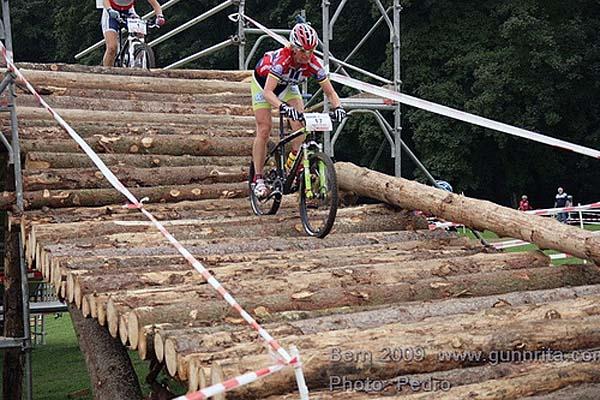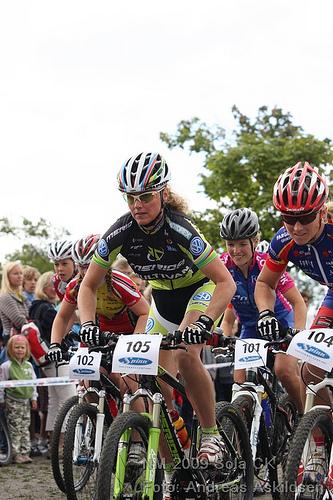A study in contrasts
From the marathon worlds to the Birkerbeinerritt


Nationalwide celebration on two wheels
I went from a reasonably solitary bike ride in the mountains at the marathon World Champaionships to mud-wrestling amongst thousands of cycling enthusiasts in this year's Birkerbeinerritt bike race. Each event, with just six days in between, was a mixed experience, full of contrasts. Cycling is and will remain an experience-oriented sport at a high level.
This year's Birkerbeinerritt, the 17th so far, is the world's biggest off-road race measured in sheer numbers of participants. It ended up being a cold and wet experience for practically everybody involved. This year the grand total of participants, including the race on Friday and all the children's classes, numbered close to 25,000 cyclists. A few flagged out prior to start, due to rain and a whole lot of rain, and the mud-bath naturally caused a lot of malfunctioning equipment for many cyclists before they crossed the finish line in Lillehammer.
Personally, I started the race with the attitude that this weather suited me just fine. Cold can only be combatted by cycling even harder to keep warm. The mud made the track a lot more demanding, and therefore more exciting for a true mountain biker. Also, in a situation like this, it helps to be aware that everybody else is doubtlessly suffering a lot more than oneself.
Hitting the wall at the World Championships
The contrasts are great in this sport of ours. I competed in the Marathon World Championships in Graz, Austria, where the heat was oppressive, and the technical descents were very demanding for one who hasn't been able to practice much technique for the last year. The whole ride, 84 kilometres and with a good 3,000 metres of altitude variation, wasn't exactly a piece of cake. I started losing energy before the fourth food stop, and at that point I still had the final and highest climb ahead of me, about two hours before the finish.
I took part in a Marathon World Championship bike race for the first time in 2004, on a track which was possibly even more demanding than last weekend's. The biggest difference between 2004 and this time was probably my preparations. I had a very different training basis that time, and moreover, I didn't hit the wall during that race. Most athletes have experienced hitting the wall at least once, either when training or during a race, and it's not a good feeling at all.
The feeling of emptiness came creeping up on me a good two hours into the race, despite having stuffed my pockets with more food than normal and eating more often and in greater quantities than ever before during a marathon race. The climb up the final mountain is one I will never forget. I ended up testing many of the bottles that other cyclists had thrown away on the way up, and asked many a hiker whether they had a bit of extra water for a needy wayfarer.
My pockets were totally empty. At the most critical point, even mushrooms along the track were taken into consideration. I must have looked totally desperate when I reached the top and a neutral food stop tempted me with some delicious sugar-drink delicatessens. I had a good break at the top, and drank large quantities of liquid, but their effect only lasted for a few minutes. If you've allowed yourself to go completely empty, it can take several hours and the rest of the day for the body to really recover.
I passed the finish line as number 13 having taken four hours and 53 minutes. I was happy and satisfied, and pretty beaten up from head to toe.
We received a lot of valuable help from the organization, both regarding living quarters and help with getting around the track. The marathon race in Graz is something we'd love to do again, and for those who enjoy a lot of climbing and technical descents, this is definitely a race worth taking part in. Also, the town of Graz is a lovely place if you enjoy shopping and good food.
Preparations for the Birkerbeinerrittet
With a strong focus on rest and recovery during the few days we had left before Birkebeinerrittet, I was in great doubt about what I could really expect of myself only six days after the major effort at Graz. Before the race, I did my usual warming up routine on the rollers, but the rain and the low temperature meant that I was stiff as anything even before I had reached the starting line. I think that just about all the women were in the same condition as me when the race started and the rain came bucketing down.
The elite women's class started at 08:30 and it had been raining non-stop since the evening before. We rode more or less together up to Skramstasæter where the first sprint bonus is placed. My body felt okay, not great but not bad either, but I had the attitude that I was going to give everything today. I was the first one into the long hill where most riders have to dismount and run, but I quickly got back on my bike as this part of the track had been improved a lot since I last took part in 2005.
I noticed immediately that my legs had become terribly cold, and that I simply had to keep pedaling hard to maintain my bodily warmth. I felt that I had a good flow on the muddy ground and received encouraging shouts from the fellows I cycled past. I had a good distance back to the next woman at this point, where the first tough patch of terrain was finished, so I told myself to just pedal as far as my legs would carry me and see how long I could last.
Even though my legs and arms were stiff from the cold, I could feel that I had power in my legs and that I was maintaining good speed. It's a very long time since I've had this feeling on my bike and it is in itself a huge motivational factor. The flow, the power and the contact with my muscles was like night and day compared to the previous weekend when I did the World Championship race.
We gambled a bit regarding choice of tires, selecting very light and narrow ones with low profile nobs. Moreover, I was on a stiff fork for the first time ever in a mountain bike race. It was a very positive experience in every way. My greatest challenge was to keep my fingers alive. Using my fingers to brake really hurt, and I had so little sensation in my arms that it was difficult at times to keep holding the bars. It was very uncomfortable descending at high speed and feeling that I was going to lose my grip going over even the smallest bump.
The cold weather never got the better of me, thanks to the cheering spectators along the track, the hundreds of cyclists I passed, my focus on eating regularly every 20 minutes in order not to hit the wall, and the challenge of staying on my bike. I was extremely focused throughout, and felt that my body was working well despite it all, and that's when I enjoy myself on my bike the most. In addition, I had to keep pedaling hard to avoid Kenneth catching up with me. He started only five minutes behind me, and we naturally had a private competition about who would cross the finish line first. Even though Kenneth beat my time, he never got the satisfaction of passing me.
I crossed the finish line just about as unrecognizable as the rest of the participants. Moreover, most people couldn't see too clearly as they crossed the finish line due to lots of sand and muck in their eyes. Unbelievably many glasses lay strewn along the track this year, so anybody going for a hike across the mountain the following day looking for glasses will have been able to fill several sacks.
Winning Birkerbeinerrittet again was a very big experience for me. First time I took part was in 1995, my first summer on a mountain bike, but back then it was also fantastic being the first woman to cross the finish line at Lillehammer. Birkerbeinerrittet has really become a nationwide celebration which many people have a relationship to, in addition to this being an arena for meeting likeminded people and experiencing true cycling enthusiasm. It was also great to see that our marathon guys from Multivan Merida Biking team came to Norway and dominated the race. Andreas Kugler of Switzerland had a great finish and won the race as Hannes Genze of Germany finished in third position.
The organization and all the volunteers, about 2,400 people, once again deserve all manner of applause for their effort. They have given thousands of cycling enthusiasts an experience they will never forget, once again, a memory which will keep most of us going for a long time.
We're back in Sandnes now, where we're going to have a few relaxed days with lots of rest and slow paced training. Next travel for the family will be to Estonia where I'll be taking part in the European Marathon Championships on the 19th of September.
Bjørnar got to experience Birkerbeinerrittet for the first time in his life, and he really enjoyed himself. There will doubtless be many more Birkerbeinerrittets for that lad too. Remember that it's only a few months before the deadline for signing up for next year's Birkerbeinerritt. And it's never too early to begin exercising.
Cyclist's greetings from Gunn-Rita, Kenneth and Bjørnar
Multivan Merida Biking Team
www.gunnrita.com
[Translation: Crispen T. P. de Lange]
Get The Leadout Newsletter
The latest race content, interviews, features, reviews and expert buying guides, direct to your inbox!
Norwegian cross country mountain bike racer Gunn-Rita Dahle Flesjå is a favorite on the international mountain bike circuit. For years, she has delighted loyal fans as she raced her heart out in cross country and marathon events.
She made an impressive comeback in 2008 after a season of illness. In 2008, she won the Madrid, Spain, round of the UCI World Cup and the UCI Marathon World Championships and finished 12th in the World Cup final standings.
Dahle Flesjå then took on the challenge of motherhood in 2009 when she gave birth to her first child in the spring. With the support of her husband Kenneth Flesjå and her family, she returned to competition within a few months after becoming a mother.
Dahle Flesjå was World Champion in 2002, 2004, 2005, and 2006, plus Olympic champion in 2004. In 2003 to 2006, she dominated the sport, winning the World Cup overall.
Follow her faithfully recounted exploits on Cyclingnews as she balances the roles of mother and elite racer. Or, for more Gunn-Rita, see her personal website: